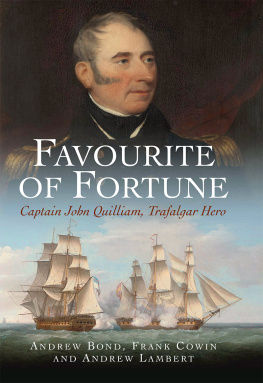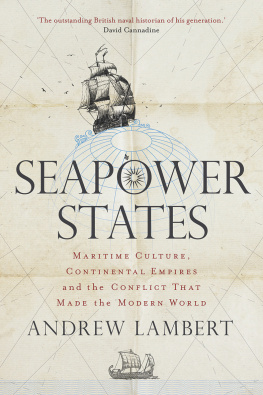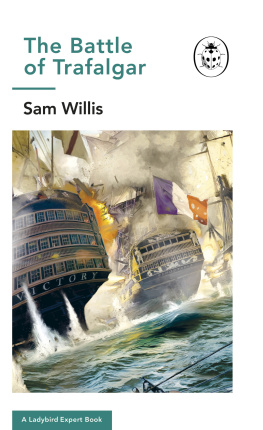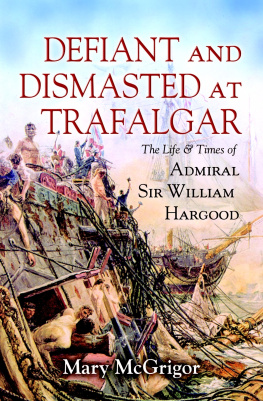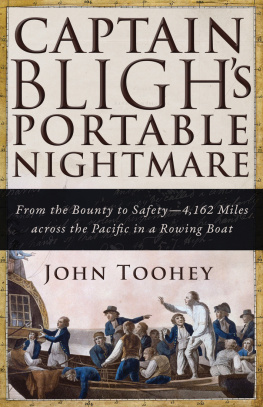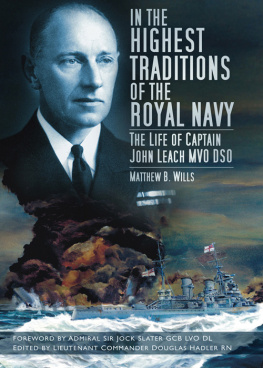Pagebreaks of the print version

F AVOURITE OF F ORTUNE
F AVOURITE OF F ORTUNE
Captain John Quilliam Trafalgar Hero
A NDREW B OND , F RANK C OWIN AND A NDREW L AMBERT
Published with the support of the Quilliam Group, Robin Crellin and Hamish Ross
Endpapers: A CORRECT PLAN of the Isle of Man By PETER FANNIN, MASTER in His MAJESTYs ROYAL NAVY. Dedicated to the Duke of Atholl and published in 1789, Fannins map includes a view across Douglas harbour from the Dukes house and a plan of the harbour showing the damaged precursor to the Red Pier. Fannin had been master of HMS Adventure on Captain Cooks second expedition to the South Seas in 17725 and subsequently established a school of navigation in Douglas.
Copyright Andrew Bond, Frank Cowin and Andrew Lambert 2021
First published in Great Britain in 2021 by
Seaforth Publishing
An imprint of Pen & Sword Books Ltd
47 Church Street, Barnsley
S Yorkshire S70 2AS
www.seaforthpublishing.com
Email
British Library Cataloguing in Publication Data
A CIP data record for this book is available from the British Library
ISBN 978-1-3990-1270-6 (Hardback)
ISBN 978-1-3990-1271-3 (ePub)
ISBN 978-1-3990-1272-0 (Kindle)
All rights reserved. No part of this publication may be reproduced or transmitted in any form or by any means, electronic or mechanical, including photocopying, recording, or any information storage and retrieval system, without prior permission in writing of both the copyright owners and the above publisher.
The moral rights of the authors have been asserted.
Pen & Sword Books Limited incorporates the imprints of Atlas, Archaeology, Aviation, Discovery, Family History, Fiction, History, Maritime, Military, Military Classics, Politics, Select, Transport, True Crime, Air World, Frontline Publishing, Leo Cooper, Remember When, Seaforth Publishing, The Praetorian Press, Wharncliffe Local History, Wharncliffe Transport, Wharncliffe True Crime and White Owl.
Authors Preface
Frank Cowin and Andrew Bond both grew up aware from an early age of a connection with the man who steered the Victory at Trafalgar. In Franks case, that connection manifested itself in a three-quarter length portrait of Captain John Quilliam R.N., which dominated the main room of the family home. Family legend had it that Franks great, great grandmother, Jane Quilliam, was Captain Quilliams sister. That suggested that she might be the captains youngest sibling whose paternity was queried at her baptism but who subsequently disappeared from the records. In fact, what the records do show is that she was claimed in a deed as the beloved child of another member of the Quilliam family, so the direct connection remains unproven.
Andrew Bonds connection is that the captains wife, the former Margaret Christian Stevenson, was his four times great aunt. Andrews grandmother, born Alice Woods, was a direct descendant of Margarets sister Charlotte, the chatelaine of the family seat, Balladoole, and would regale the family with tales of visits to the house where, when the wind blew, the carpets rose from the floor.
Franks mother researched John Quilliams naval career both locally in the Isle of Man and in London at the Public Record Office in Chancery Lane and later at Kew. With the bicentenary of Quilliams birth approaching, however, she handed her material over to Frank who, after further research, presented it in a paper to the Isle of Man Natural History and Antiquarian Society, which they published in 1972. Frank subsequently continued to research Quilliams later life, greatly assisted by his brother, Noel.
Andrew Bonds interest was triggered by another bicentenary, that of Trafalgar itself in 2005, which prompted both a visit to HMS Victory at Portsmouth and a subsequent trip to the Island. When retirement some years later freed up the time to pursue Quilliam in more detail, that 1972 paper soon led to Frank and regular contacts followed. At the National Archives and elsewhere, Andrew was able to track Quilliams career day by day through dockyard records, muster, pay and log books, court martial papers and correspondence.
Meanwhile, in 2015, the Quilliam Group, which had been formed on the Island to commemorate and promote wider interest in Quilliams life, had invited Andrew Lambert, the Laughton Professor of Naval History at Kings College, London, to deliver its annual lecture at Arbory church. Each year the lecture forms part of Trafalgar Day observances, which include contributions from pupils at the local primary school and members of the British Legion. On that occasion it also saw the dedication of the stained glass window commissioned by the Group depicting Captain Quilliam.
Following the success of his lecture on Quilliams service after Trafalgar, the Group approached Professor Lambert with a view to his expanding his paper into a full-length biography. However, already well aware of both Franks and Andrews researches, he very generously suggested that the project would be best approached as a tripartite enterprise. The end result combines his unrivalled knowledge of Nelsons navy with Franks deep understanding of all things Manx and Andrews forty years as a journalist and editor.
Illustrations
Endpapers
A CORRECT PLAN of the Isle of Man By PETER FANNIN, MASTER in His MAJESTYs ROYAL NAVY, 1789 . Manx National Heritage P.1275/2 (P.XX 3L).
Between pages 14 and 15
.
.
.
.
.
.
.
.
.
.
.
.
.
.
Between pages 62 and 63
.
.
.
.
.
.
.
.
.
.
.
.
.
.
.
.
MAPS
Introduction
Of the three senior officers on the quarterdeck as HMS Victory closed on the combined French and Spanish fleet off Cape Trafalgar on the morning of 21 October 1805, one, already a national hero, would become the iconic embodiment of British naval power. Another would go down in history as the archetypal faithful subordinate and friend, immortalised in his chiefs dying words: Kiss me, Hardy. The third, Victory s first lieutenant John Quilliam, is barely recognised outside his native Isle of Man. However, there he is the hero, celebrated in statuary, stained glass, museum exhibits and a re-enactment by school children each Trafalgar Day. Every Manxman and Manxwoman has a story of Captain Quilliam, and some of them may even be true.
That Quilliam is so little known in the wider world is all the more remarkable, given his extraordinary career, which can be compared with those of the great heroes of naval fiction, Hornblower and Aubrey. He began with a voyage halfway round the world, conveying Britains first ambassador to China, and continued through all twenty-three years of the Revolutionary and Napoleonic Wars. Almost uniquely, he took part in no fewer than three major fleet actions before Trafalgar including Camperdown and Copenhagen, when only a tiny proportion of the thousands who served at sea over the period saw even one. Nevertheless, the histories and biographies of the period allow him barely a mention and are often factually incorrect. Local accounts have challenged some of the Quilliam mythology, but this is a life that belongs on a larger stage.

